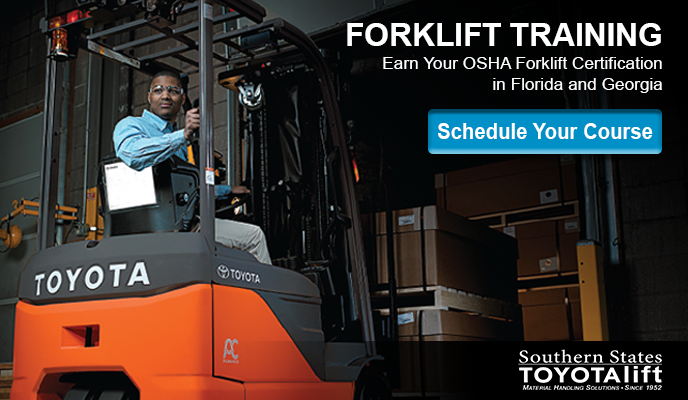Going the Distance for Warehouse Safety
by James Averitt, on Jun 10, 2024 9:00:00 AM
 In a warehouse, distances matter more than knowing what fits where. They are also crucial to keeping your facility safe. So whether you’re looking for your monthly safety topic or just want some simple ways to improve safety, here are three vital safety distances that every material handling and manufacturing operation should know.
In a warehouse, distances matter more than knowing what fits where. They are also crucial to keeping your facility safe. So whether you’re looking for your monthly safety topic or just want some simple ways to improve safety, here are three vital safety distances that every material handling and manufacturing operation should know.
Distance From Moving Industrial Equipment
According to OSHA reporting, forklift accidents kill 85 people on average per year. Forklift safety features help reduce the chance of this happening in your facility. Still, the most effective means of improving pedestrian warehouse safety is to keep pedestrians away from moving industrial equipment. Pedestrians should maintain a minimum of five feet between themselves and a moving forklift that is not in the process of lifting. Where possible, expand this distance to ten feet.
However, lifting increases the minimum safe distance pedestrians must maintain. Add the forklift's lifting height to the safe distance benchmarks above to calculate this. Thus, if a forklift can lift up to 22 feet, pedestrians must maintain a minimum safe distance of 27 feet, with 32 feet or more being ideal. These distances ensure pedestrians remain clear if the forklift tips during lifting.
Warehouse Walkway Safety
Pedestrian walkways are an effective method for separating pedestrians from forklift traffic. The thoroughfares through the warehouse tell pedestrians where they are safe to walk during periods of forklift activity. OSHA regulation 29 CFR 1910.176(a) states that pedestrian pathways must always be clearly marked and remain free from obstruction. The practicality of this guideline is obvious. Pedestrians must know the boundaries of these pathways, and they must stay clear to be useful. Additionally, OSHA says that pedestrian walkway width requirements must be at least 24 inches wide. However, ADA’s warehouse pedestrian walkway requirements specify that such pathways be at least 32 inches wide.
One option is to mark pathways with paint or floor tape. However, such markings wear out over time and must be refreshed to ensure OSHA compliance. Alternatively, physical barriers provide clear markings as well as additional collision protection for pedestrians. Consider installing railings or guards to separate pedestrian pathways from forklift traffic where feasible. Whichever method you choose, prioritize warehouse pedestrian safety lighting to ensure forklift operators see pedestrians moving through the area.
Fire Extinguisher Safety Topics
 US fire departments respond to approximately 1,450 fires in warehouses annually. On average, these fires cause $283 million in property damage. Fire extinguishers are the first line of defense against these damages. However, fire extinguisher placement plays a critical role in the effectiveness of that defense. The maximum acceptable travel distance to retrieve a fire extinguisher varies depending on the extinguisher class, with the greatest distance being 75 feet.
US fire departments respond to approximately 1,450 fires in warehouses annually. On average, these fires cause $283 million in property damage. Fire extinguishers are the first line of defense against these damages. However, fire extinguisher placement plays a critical role in the effectiveness of that defense. The maximum acceptable travel distance to retrieve a fire extinguisher varies depending on the extinguisher class, with the greatest distance being 75 feet.
There are five extinguisher classes, each with their own maximum travel distance:
- Class A: 75 feet (May be reduced by the floor area. More on that below.)
- Class B: 30 feet or 50 feet (Varies based on type of hazard and numerical B rating)
- Class C: This fire extinguisher class is always either Class A or Class B in addition to
- Class C. Use the most conservative value of the other associated classes.
- Class D: 75 feet
- Class K: 30 feet
Fire Extinguisher Distance Notes From NFPA
Floor area and hazard type may reduce the travel distance of a Class A extinguisher. This is especially important for warehouses, as their open design is most likely to reduce the travel distance for this extinguisher class.
It is equally important to note that these distances do not necessarily represent linear distances but rather the actual distance someone must travel to reach the extinguisher. For example, suppose an extinguisher is on the other side of a wall. In that case, the maximum distance must take into account leaving the original room through a door and traveling to the extinguisher without requiring the user to pass through a solid wall.
Likewise, any person within the coverage area must be able to reach the fire extinguisher without traveling more than the maximum distance. For example, let's consider a rectangular room that requires two Class A fire extinguishers. Assuming a maximum travel distance of 75 feet for each extinguisher, one might think the extinguishers could be 150 feet apart because someone standing between them would never be more than 75 feet from one. However, this would create pockets in the room where someone could be more than 75 feet from either extinguisher. Thus, the extinguishers must move closer together until everywhere in the room is within 75 feet of one extinguisher.
Your Partner in Warehouse Safety
Warehouses are in the business of spacial management. That same understanding of area and distances is crucial in maintaining a safe facility. By ensuring proper distances between pedestrians, forklifts, workers, and fire extinguishers, you can help minimize two of the greatest dangers warehouse workers face. Don’t let your facility become another statistic. Instead, go the distance for warehouse safety.
If you’re ready to work towards a safer warehouse, Southern States Toyotalift can help. Our experts have decades of experience in warehouse safety. We can provide the training and equipment you need to protect your team. To learn more about warehouse safety training or invest in safety equipment, contact us online or visit one of our locations throughout Georgia and Florida.
Florida
Jacksonville
Lakeland
Ocala
Orlando
Tampa
Winter Haven
Georgia
Albany
Macon
Columbus
Valdosta
Further Reading
How To Reduce Super Scary Forklift Risks
5 Simple Steps to Improve Warehouse Safety
6 Different Types of OSHA Fines – What Warehouses in Florida & Georgia Need To Know









